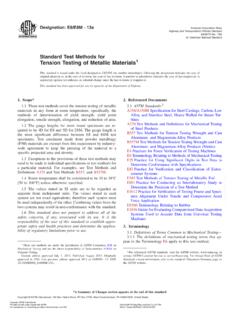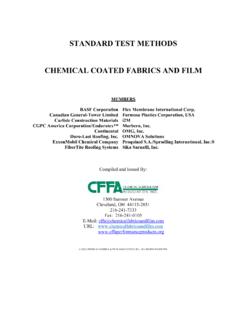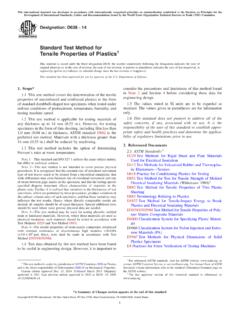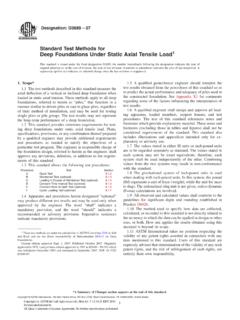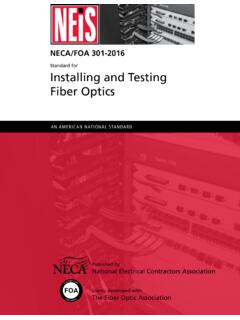Transcription of Standard Test Methods for Bend Testing of Material for ...
1 Designation: E290 14 Standard Test Methods forBend Testing of Material for Ductility1 This Standard is issued under the fixed designation E290; the number immediately following the designation indicates the year oforiginal adoption or, in the case of revision, the year of last revision. A number in parentheses indicates the year of last reapproval. Asuperscript epsilon ( ) indicates an editorial change since the last revision or Standard has been approved for use by agencies of the Department of Scope* These test Methods cover bend Testing for ductility ofmaterials. Included in the procedures are four conditions ofconstraint on the bent portion of the specimen; a guided-bendtest using a mandrel or plunger of defined dimensions to forcethe mid-length of the specimen between two supports separatedby a defined space; a semi-guided bend test in which thespecimen is bent, while in contact with a mandrel, through aspecified angle or to a specified inside radius (r) of curvature,measured while under the bending force; a free-bend test inwhich the ends of the specimen are brought toward each other,but in which no transverse force is applied to the bend itselfand there is no contact of the concave inside surface of thebend with other Material .
2 A bend and flatten test, in which atransverse force is applied to the bend such that the legs makecontact with each other over the length of the After bending, the convex surface of the bend isexamined for evidence of a crack or surface irregularities. Ifthe specimen fractures, the Material has failed the test. Whencomplete fracture does not occur, the criterion for failure is thenumber and size of cracks or surface irregularities visible to theunaided eye occurring on the convex surface of the specimenafter bending, as specified by the product Standard . Any crackswithin one thickness of the edge of the specimen are notconsidered a bend test failure. Cracks occurring in the cornersof the bent portion shall not be considered significant unlessthey exceed the size specified for corner cracks in the The values stated in SI units are to be regarded asstandard. Inch-pound values given in parentheses were used inestablishing test parameters and are for information Standard does not purport to address all of thesafety concerns, if any, associated with its use.
3 It is theresponsibility of the user of this Standard to establish appro-priate safety and health practices and determine the applica-bility of regulatory limitations prior to Referenced standards :2E6 Terminology Relating to Methods of Mechanical TestingE8/E8 MTest Methods for tension Testing of Metallic Ma-terialsE18 Test Methods for Rockwell Hardness of Metallic Ma-terialsE190 Test Method for Guided Bend Test for Ductility ofWelds3. Summary of Test Four Methods for ductility Testing employing bendingare included in these test Methods . Three Methods havesubgroups with specific Guided Bend, No Die, Guided Bend, U-Bend, Guided Bend, V-Bend, Guided Bend, V-Bend for cold rolled sheet, A,specimen held at one B,for thin C,mandrel contact force in the 1,180 2,bend flat on and A guided-bend test for ductility of welds is described inMethodE190and may be used for flat-rolled materials whenspecified by the product Standard .
4 The essential features of thisbending method are employed , Guided Bend, Bend tests are made in one of two directions relative tothe principal working direction employed in production pro-cessing of the test method is under the jurisdiction of ASTM CommitteeE28onMechanical Testing and is the direct responsibility of and edition approved May 1, 2014. Published September 2014. Originallyapproved in 1966. Last previous edition approved in 2013 as E290 13. referenced ASTM standards , visit the ASTM website, , orcontact ASTM Customer Service at ForAnnual Book of ASTMS tandardsvolume information, refer to the Standard s Document Summary page onthe ASTM website.*A Summary of Changes section appears at the end of this standardCopyright ASTM International, 100 Barr Harbor Drive, PO Box C700, West Conshohocken, PA 19428-2959. United States1 Copyright by ASTM Int'l (all rights reserved); Sat Feb 28 16:12:31 EST 2015 Downloaded/printed byNew York University pursuant to License Agreement.
5 No further reproductions Longitudinal tests use a specimen with its long dimen-sion aligned with the processing direction such that the bend isformed across the processing direction, as shown inFig. Transverse tests use a specimen with the long dimen-sion perpendicular to the processing direction so that the bendaxis is aligned with the processing direction, as shown The axis of bend is the center of the bend Thin sheet products are generally produced by reduc-ing the thickness of stock in rolling mills and from this the termrolling direction is used to identify the principal processingdirection. Similarly, a product produced in coil form may havethe processing direction referred to as the coiling The location of the force application to the specimenrelative to the bend itself and the amount of bending differen-tiate the four Methods of bending covered in these testmethods. The two semi-guided bend test procedures provideradiused surfaces over which the bend is formed.
6 The resultsobtained by different test procedures may not be the same,especially for Material with a tendency to crack or The test is completed when the designated angle ofbend, or other specified condition, has been If a defined amount of cracking is permitted by theproduct Standard , the convex surface of the bend region isexamined for cracks and surface Surface irregularities, such as orange peel, loss ofcoating adherence, or imperfections resulting from the bend,shall be noted as required by the product Bend The guided-bend test is made by sup-porting the specimen near each end on pins, rollers, or flatsurfaces with appropriate end radii and applying a forcethrough a pin, mandrel, plunger, or male die midway betweentwo supports, as shown schematically inFig. 3,Fig. 4,Fig. 5,andFig. 6until the desired bend is formed. No force is applieddirectly to the outer face of the bend when no female die isused ( ). Some force may be applied by the female die tothe outer face of the bend in the case of U-bend ( ) andV-bends ( ).
7 In some cases, for U-bend andV-bends it may be necessary for the specimen to bottom out inthe female die to ensure the correct amount of The radii of the plunger and of the two supports shallbe defined in the product specification as related to thethickness (t) of the specimen being tested. A clearance of threethickness with a tolerance of one half thickness shall beprovided between the pins, plunger, and specimen in the initialbend The distance between supports (C) shall be threethicknesses plus twice the plunger radius, with a tolerance ofone-half thickness, as shown inFig. When female dies are used for U-bend and V-bend,they shall conform approximately to the geometries shown inFig. 4,Fig. 5, andFig. The surfaces of the supports and plunger shall be hardenough to resist plastic deformation and wear that can beobserved after the test. If visible flattening, wear, or otherpermanent deformation of the test fixtures does occur, the testis Supports and plungers hardened to at least 20 HRC have beenfound to be generally suitable for this test.
8 It is recommended thatchecking by the unaided eye for flattening, wear, or other deformation ofthe test fixtures take place after Testing different and potentially hardermaterials than The supports can be fixed or free to rotate. A lubricantmay be applied to the supports and The width of the guided-bend fixture, including thesupports and plunger, shall be such that the bend region of thespecimen is subject to the bending force across its width (w)during When the thickness or strength of the specimen, orcapacity of the guided-bend test fixture (shown inFig. 3) doesnot produce the required amount of bending, the specimen canbe removed from the fixture and the bend completed byapplying force against the ends of the specimen, as shownschematically inFig. 7. A spacer with a thickness equal totwice the required bend radius is inserted at the location of thebend. The edges at the ends shall be constrained so thespecimen cannot eject from the fixture under the bending Surface cracks and imperfections resulting from thebend shall be evaluated and Bend The semi-guided bend test employsa constraining force on the inside of the bend during theinitiation of the bending and continuing until the final bendcondition is The semi-guided bend test is made by applying a forcetransversely to the specimen s long axis in the portion that isbeing The angle of bend in the semi-guided bend test ismeasured while the specimen is held stationary under the forceforming the The location of the bend along the length of thespecimen is unimportant.
9 The specimen is clamped or sup-ported by one of the Methods shown schematically Arrow indicates direction of 1 Longitudinal Bend TestNOTE1 Arrow indicates direction of 2 Transverse Bend TestE290 142 Copyright by ASTM Int'l (all rights reserved); Sat Feb 28 16:12:31 EST 2015 Downloaded/printed byNew York University pursuant to License Agreement. No further reproductions C= distance between lower supports,r= radius of the end of the mandrel or plunger,t= sheet specimen thickness,d= round specimen diameter, andw= sheet specimen 3 Schematic Fixture for the Guided Bend, No Die TestFIG. 4 Schematic Fixture for the Guided Bend, U-bend TestE290 143 Copyright by ASTM Int'l (all rights reserved); Sat Feb 28 16:12:31 EST 2015 Downloaded/printed byNew York University pursuant to License Agreement. No further reproductions It is possible that different results will be obtained withthe use of different devices. The method used shall bedescribed in the test report on the ductility of the Material A One End Held Arrangement A in-volves holding one end of the semi-guided bend specimen andapplying a force transversely near the free end as inFig.
10 8. Thebend is formed around a stationary pin, mandrel, or roller of aspecified radius. Bending is continued until failure occurs orthe specified angle of bend has been B Thin Materials Arrangement B isfor semi-guided bend tests of thin specimens, and includes asupport between the clamp and the bend radius, as shownschematically inFig. 9. No tension force is applied to thespecimen during the bending. The results should be the samefor tests using either Arrangement A, or Arrangement C Mandrel Contact on OuterSurface Arrangement C employs a stationary pin, or mandrel,over which the semi-guided bend specimen is bent by the forceof a roller, or mandrel, in contact with the outer surface of thebend (as shown schematically inFig. 10). This may exert asmall tension force in the bend. The test is sometimes referredto as awrap, but it is distinct from thewrap aroundwire testdescribed in Surface cracks and irregularities resulting from thebend shall be evaluated and 5 Schematic Fixture for the Guided Bend, V- Bend TestE290 144 Copyright by ASTM Int'l (all rights reserved); Sat Feb 28 16:12:31 EST 2015 Downloaded/printed byNew York University pursuant to License Agreement.



